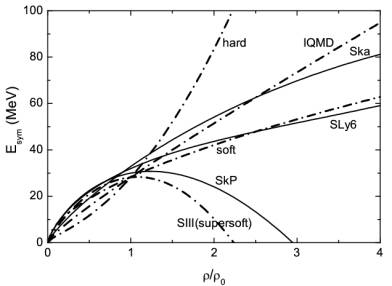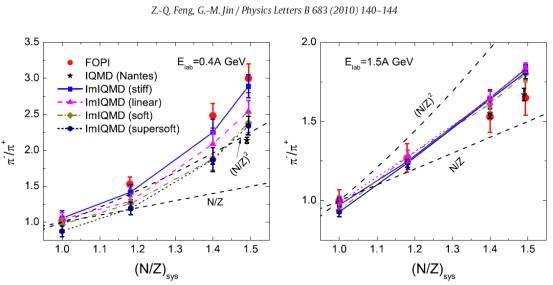Recently, the properties of the nuclear symmetry energy at supra-saturation densities were extracted through the pion emission in high energy heavy-ion collisions (HICs) based on the improved isospin dependent quantum molecular dynamics (Im-IQMD) model developed by the nuclear theory group at Institute of Modern Physics, Chinese Academy of Sciences. It is shown that the isospin asymmetric nuclear matter is hardly compressed at high densities.
The properties of the isospin asymmetric nuclear matter (the ratio of protons and neutrons in the matter) plays an important role in the study of astrophysics, such as the structure of neutron star, the nucleosynthesis during supernova explosion of massive stars etc. Up to now, the knowledge of the isospin asymmetric nuclear matter at high densities is very limited and the available experimental data are very scarce. It would be feasible to investigate some observables that are emitted at high densities in terrestrial HICs in order to extract the information of the high-density symmetry energy. The pion meson is mainly produced in the region of supra-saturation densities at 1 A GeV energies. Therefore, the isospin sensitive variable such as the p-/p+ ratio could be a probe of the high-density properties of the symmetry energy. In the ImIQMD model, different trends of the symmetry energies with density can be chosen, such as the symmetry energy increasing monotonically with the baryon density, or the symmetry energy increasing initially up to a supra-saturation density and then decreasing at higher densities as shown in Fig. 1. Calculatedπ-/π+ ratios with different stiffness of the symmetry energy are shown in Fig. 2 as a function of N/Z of the systems in the reactions 40Ca+40Ca, 96Ru+ 96Ru, 96Zr+96Zr and 197Au+197Au, and also plotted the ratios of N/Z and (N/Z)2 as a function of N/Z at incident energy 0.4A GeV and 1.5A GeV, respectively. The FOPI data at GSI heavy ion research center and the IQMD results by Nantes group are also given for a comparison. Theπ-/π+ yields are sensitive to the stiffness of the symmetry energy near threshold energy. The stiff symmetry energy is close to the experimental data. These results are helpful for understanding experimental data and need to be further confirmed in future experiments, especially at the HIRFL-CSR (Heavy Ion Research Facility in Lanzhou-Cooling Storage Ring).
The results have been published in Physics Letters B 683 (2010) 140-144。

Fig. 1 The density dependence of the nuclear symmetry energy for different Skyrme forces SkP, Sly6, Ska and SIII, and for the cases of linear, hard and soft trends.(Picture/IMP)

Fig. 2 The π-/π+ yields as a function of the neutron over proton N/Z of reaction systems for head on collisions at incident energy Elab=0.4A GeV and 1.5A GeV, respectively. (Picture/IMP)

